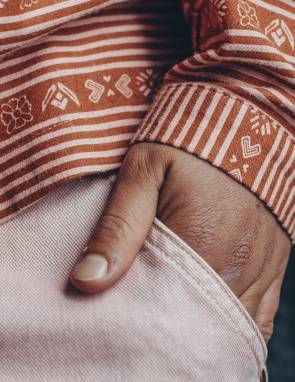Back to Nature
02.04.2020, 12:04 Uhr
The use of natural fiber for functional sportswear established itself
Inspired by nature: The use of natural fibres, in particular for functional sportswear, has established itself meanwhile among the many manufacturers. This is evident in the innovations of the many fabric manufacturers at Performance Days.
By Astrid Schlüchter
Its is becoming increasingly apparent that sustainably produced materials can be a real alternative to synthetic fibres. The latter also trigger serious drawbacks in their wake: they are usually crude oil based, a finite raw material whose extraction causes massive environmental damage worldwide. These petroleum-based synthetic fibres are not biodegradable and therefore also problematic in terms of disposal. Not to mention the many ingredients harmful to our health, which when worn, can trigger unpleasant side effects or even troubling allergies. The number of genuine alternatives applied in the sportswear and lifestyle industry have been quite modest up until now – but they do exist: with companies placing increasing emphasis on sustainably produced materials, manufacturing fair sportswear from recycled or pollutant-free synthetic fibres or from natural fibres and ensuring that production conditions take environmental and social acceptability issues into account. It should also not be forgotten that manufacturers are generally dependent on fabric suppliers who, from season to season, are constantly working on environmentally friendly developments in the field of natural fibres. At Performance Days, many fabric manufacturers are demonstrating a “green thumb” for the S/S 22 season, with increased focus on innovative fibre solutions that combine performance with sustainability and offer a choice of functional fabrics that are breathable, heat regulating, water-repellent, antibacterial and UV-protective. The result is great fabrics that are suitable for everyday use, as well as for sporting activities in leisure time, or on the way to work, and are, at the same time, also ecological and sustainable.
Environmentally friendly by nature: animal fibres
Natural fibres generally have their origins in plants or animals. One of the best known fibres derived from animals is wool, in particular from merino sheep, alpacas, goats or the shaggy yak. In addition to those, silk, cashmere, and of course down material in winter, are increasingly used for functional purposes. Above all, the combination of fine merino fibres with smooth, robust silk ensures optimum breathability while having a temperature-regulating effect. An admixture of elastane supports the natural elasticity of the wool fibre and gives the garment a high level of shape retention throughout all movement.
The Südwolle Group has been using merino wool yarns for the sports and outdoor industry for a long time now, and is now offering a newcomer with Coolmax fibre as an “EcoMade” alternative. “EcoMade” fibres consist of a verified proportion of recycled resources such as PET bottles. In combination with merino wool, sportswear becomes extremely durable and has a thermo-regulating effect. As part of their “karma” motto, the company is also presenting a new project which involves bringing old woollen fabrics back to life. How? By first shredding textiles into fibres and then spinning them back into new wool fibres.
Schoeller GmbH & Co KG swears by alpaca wool due to the fact that the fine wool in its various forms boasts very special properties that offer more than just warmth. The fibres are hollow on the inside and thus feature unique thermal properties that make it possible to wear alpaca clothing in both summer and winter. The focus is on softshell jackets made of 100 percent merino or alpaca fibres, which are extremely breathable, naturally water repellent and also provide a thermoregulatory effect during outdoor activities. Furthermore, attempts are made to retain the natural colouring of the wool in order to abstain from chemical dyeing processes. The EXP (Ex-Pollution) process ensures that wool can be fully machine washed without the usual chlorine exposure. Thanks to EXP, drying in a tumble dryer is even possible. The Südwolle Group also uses a similar process. The Naturetexx Plasma and X-Care methods refrain completely from the use of chlorine.
Apparel made from nature: plant-based fibres
Along with linen, cork, sisal or coconut, cotton is certainly the most familiar plant-based fibre. This is mostly cultivated in a controlled environment with companies attempting to guarantee a greater contribution to the environment by avoiding the use of hazardous pesticides and by using less energy and water. Clothing made of organic cotton is durable, comfortable to wear and a sustainable alternative to conventional cotton. Kapok fibre is an ecologically very interesting raw material, as the fibre is extracted from the fruit capsules of the “ceiba pentandra” (kapok tree), which continuously regenerate. A single tree yields about 20 kilogrammes of pure fibre annually. Kapok fibres have a silky-smooth surface, which is why they do not felt or lump like wool or cotton, and are covered with a fine layer of wax, which ensures that moisture is quickly passed on, and not absorbed or retained. The fibres can be used to make sustainable yarns, fabrics and fillings.
Hemp is also increasingly being used as a plant-based fibre. Why? As a pioneering plant, it can grow practically anywhere, and quickly. The decisive factor is that it requires much less water than cotton when cultivated. The resistant plant also has no need for pesticides. A further advantage is that the fibre abrasion during the washing process does not harm the environment and abstains from the release of any microplastic. On the technical side, hemp fibres also have a lot to offer. They are naturally perspiration- and odour inhibiting, possess particularly good moisture regulating properties, and dry quickly. They also provide a cooling effect, are abrasion resistant, dirt resistant and have an antibacterial impact.
So it comes as no wonder that more and more brands are using hemp fibres in their collections, among others Maloja for example in their bike and running lines. Moisture retention, reduction of sebum production, UV protection, antibacterial effects and boosting of cell renewal are just a few examples of the miraculous care effect accredited to algae. The essentially traditional German company Mattis had the idea to combine the healing effect of algae with the functionality of a garment. In an innovative project, they developed a sustainable production line of clothing that exploits the natural powers of algae. The result was the Palgero brand; functional underwear doubling up as a skin care product.
Industrially manufactured, yet ecological: regenerated fibre
The term “regenerated cellulose fibre” refers to all types of fibres that are produced from naturally renewable raw materials by means of a chemical process. The basis for the production of such a fibre is cellulose derived from wood, also known as cellulose pulp. The most important types of this kind of fibre include viscose, modal, lyocell and cupro fibres. Lyocell fibre is a cellulose fibre made from wood. The fibre production is extremely environmentally friendly due to the closed cycle of the manufacturing process. What makes it so special is that the fibre is obtained from sustainable forestry and water consumption is ten to twenty times less than that of cotton. Furthermore, the lyocell fabric, with its particularly smooth surface and silky feel, warms almost as well as pure sheep’s wool, has similar cooling qualities to linen and is more absorbent than cotton. Lyocell is also extremely tear-resistant when wet, making it especially durable and, as a moisture-regulating fibre, particularly suitable for people suffering from allergies. Tencel is the registered brand name for lyocell fibres, whereby the Austrian company Lenzing further developed the lyocell method for industrial production, finding a way to ensure that the solvents used were kept in a closed cycle. Resultantly, 99.8 percent of solvents are recovered and recycled, thus reducing chemical pollution to a minimum. Lenzing has been marketing its lyocell fibres since 2004 under the name Tencel. Since the fibre is made of wood, i.e. of botanical and thus vegan origin, the fibre is often referred to as a vegan alternative to wool.
Cupro is obtained from the fluff of cottonseeds, which are a waste product in the production process of raw cotton. The fine fibres are used to produce a fabric that has a silk-like feel and displays the same properties such as breathability, an elegant drape and a light shimmer.
Fibres for that feel-good factor: plant-based ingredients
Natural ingredients in fibres not only ensure an increased sense of well-being when worn, but also the material itself proves to be much more robust than its chemical counterparts. An example of plant-based ingredients are coffee grounds. The vast quantities of coffee grounds that amass daily can be recycled into a functional material for outdoor clothing. The best example: the innovative S.Café material from Schöffel, which is a technical fibre composite made of recycled coffee grounds and polyester. The Taiwanese textile manufacturer Singtex developed the production process for recycling the coffee grounds. In a patented process, the coffee grounds are first dried and then extracted. The coffee extract is then processed together with polyester into pellets, which form the raw material for the production of S.Café fibres. The mixture here is variable. In some cases, S.Café is also produced with nylon and varying amounts of recycled polyester. To produce the final product, the coffee pellets are mixed with the polyester, melted down and then used to produce the S.Café yarn.
Seacell is a fibre that is derived from seaweed. Algae are said to be the “fuel of the seas” and boast many positive health benefits. This is why why the fibres are particularly suitable for people who place great importance on quality, sustainability, innovation and sophistication. The perfect blend of tangible comfort and functionality is what makes the fibre ultimately so unique. As moisture is particularly well stored and subsequently transported outwards, the material has a temperature-regulating effect.
Seacell is a fibre that is derived from seaweed. Algae are said to be the “fuel of the seas” and boast many positive health benefits. This is why why the fibres are particularly suitable for people who place great importance on quality, sustainability, innovation and sophistication. The perfect blend of tangible comfort and functionality is what makes the fibre ultimately so unique. As moisture is particularly well stored and subsequently transported outwards, the material has a temperature-regulating effect.
Aloe vera is one of the oldest known plants for medicinal purposes. With its 200 active ingredients, including 75 nutrients, 20 minerals, 18 amino acids and 12 vitamins, more and more experts are praising it as a veritable “wonder plant”. In the field of textile finishing, aloe vera is applied to soften the textile and often provides a subjective pleasant sensation when worn on the skin. Additionally, small amounts of the skin-nurturing aloe vera substances are released by means of body heat.
Oeko-Tex certifications for natural fibres
- The certification of environmentally friendly and socially responsible businesses processing natural fibres according to STeP by Oeko-Tex.
- The testing and certification of chemicals and additives used in textile production with natural fibres according to Eco Passport by Oeko-Tex.
- The awarding of Standard 100 Oeko-Tex labels for textiles made from natural fibres. Standard 100 makes sense not least for textile products made of natural fibres due to the fact that sources of pollutants can originate from downstream production stages such as dyeing or finishing.
- The awarding of the Made in Green by Oeko-Tex label for textiles made from natural fibres that have been tested for harmful substances and were produced in a sustainable manner.
- The analysis according to Detox To Zero by Oeko-Tex to determine whether production companies comply with the requirements of the Greenpeace Detox campaign.
For the first time, the current issue will be released as a digital PDF dossier for download, free of charge.











